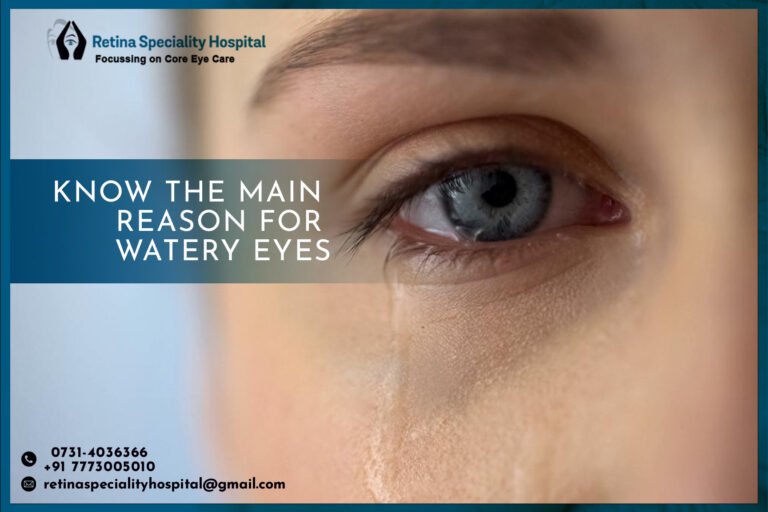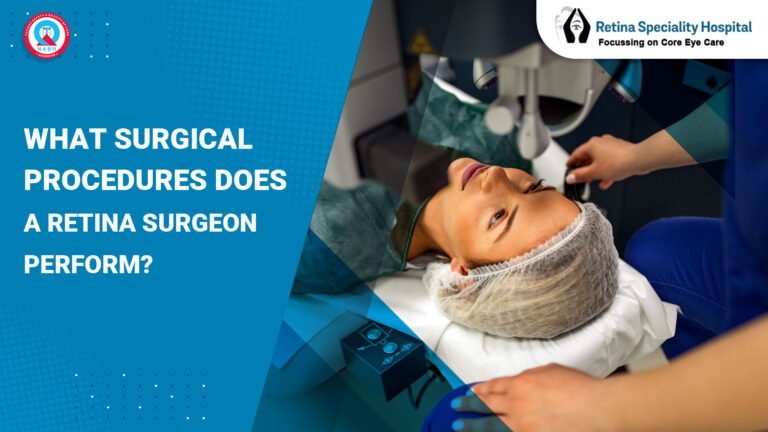Introduction
Have you ever found yourself constantly wiping away tears, even when you’re not feeling emotional? Watery eyes, also known as epiphora, can be a frustrating and sometimes embarrassing condition that affects people of all ages. In this comprehensive guide, we’ll explore the main reasons behind watery eye treatment in Indore, their symptoms, and effective ways to manage and prevent this common eye issue.
Overview of watery eyes
Watery eyes occur when your eyes produce an excess of tears or when the normal drainage of tears is impaired. While tears are essential for maintaining eye health and clear vision, an imbalance in tear production or drainage can lead to various uncomfortable symptoms. Understanding the mechanics of tear production and the factors that influence it is crucial in addressing this condition effectively.
Common Causes of Watery Eyes
Before we delve into the main reason for watery eyes, let’s explore some of the common causes that contribute to this condition:
1. Allergies
Allergic reactions are a frequent culprit behind watery eyes. When your body encounters an allergen, such as pollen, pet dander, or dust mites, it releases histamines. These chemicals can cause inflammation in the eyes, leading to increased tear production as a protective mechanism. Seasonal allergies, in particular, can cause periodic bouts of watery eyes for many individuals.
2. Dry eyes
Paradoxically, dry eye syndrome can actually lead to watery eyes. When your eyes don’t produce enough quality tears to keep the surface lubricated, they may overcompensate by producing an excess of watery tears. This reflex tearing is the body’s attempt to alleviate the discomfort caused by dry eyes, but it often results in excessive tearing that doesn’t effectively moisturize the eye.
3. Blocked tear ducts
Tears normally drain through small openings in the inner corners of your eyelids, called puncta, and then travel through the nasolacrimal duct into your nose. When these ducts become blocked or narrowed, tears can’t drain properly, leading to an overflow of tears onto the cheeks. Blockages can be caused by infections, injuries, or congenital abnormalities.
4. Conjunctivitis
Also known as pink eye, conjunctivitis is an inflammation of the conjunctiva, the thin, clear tissue that covers the white part of the eye and the inner surface of the eyelid. This condition can be caused by viruses, bacteria, or allergies, and often results in redness, itching, and increased tear production.
5. Environmental factors
Various environmental elements can irritate your eyes and trigger excessive tearing. These include:
– Wind
– Smoke
– Dust
– Bright lights
– Changes in temperature or humidity
– Certain chemicals or fumes
Exposure to these irritants can stimulate the lacrimal glands to produce more tears as a protective response.
Main Reason for Watery Eyes
While there are numerous contributing factors to watery eyes, the main reason can often be attributed to one of the following:
1. Excessive tear production
The most common primary cause of watery eyes is an overproduction of tears. This can occur due to various stimuli, including those mentioned in the common causes section. The lacrimal glands, located above each eye, are responsible for producing tears. When these glands are overstimulated or irritated, they can produce more tears than necessary, leading to watery eyes.
Tear overproduction is often a protective mechanism. When the eyes detect an irritant or a potential threat, they respond by producing more tears to flush out the foreign substance and protect the delicate eye tissues. However, this natural defense can become problematic when it occurs too frequently or intensely.
2. Irritation or inflammation
Chronic irritation or inflammation of the eye and surrounding tissues can lead to persistent watery eyes. This irritation can be caused by various factors, including:
– Allergies
– Infections
– Environmental irritants
– Certain medications
– Eye strain from prolonged screen use
When the eyes are consistently irritated, they remain in a state of heightened sensitivity, leading to increased tear production as a ongoing protective measure.
3. Underlying health conditions
In some cases, watery eyes can be a symptom of an underlying health condition. These may include:
– Thyroid disorders
– Autoimmune diseases like Sjögren’s syndrome
– Bell’s palsy
– Facial nerve palsy
– Chronic sinus conditions
These conditions can affect the normal functioning of the tear-producing glands or the structures responsible for tear drainage, resulting in watery eyes.
Understanding that excessive tear production, often triggered by irritation or underlying health issues, is the main reason for watery eyes is crucial in developing effective treatment strategies. By addressing the root cause of the overproduction, it’s possible to manage and alleviate the symptoms of watery eyes more effectively.
Symptoms of Watery Eyes
Recognizing the symptoms associated with watery eyes is important for proper diagnosis and treatment. While excessive tearing is the primary symptom, several other signs may accompany this condition:
1. Excessive tearing
The most obvious symptom is an overflow of tears that may run down the cheeks. This can occur in one or both eyes and may be constant or intermittent. Some people experience more tearing when they’re in certain environments or engaged in specific activities.
2. Blurred vision
When excess tears accumulate on the surface of the eye specialist in Indore, they can interfere with normal vision. This can result in blurred or distorted vision, which may come and go as tears are produced and drained or wiped away. Blurred vision can be particularly problematic when performing tasks that require clear eyesight, such as reading or driving.
3. Eye redness
Watery eyes are often accompanied by redness in the whites of the eyes or along the eyelids. This redness is typically caused by the irritation or inflammation that’s triggering the excessive tear production. The blood vessels in the eyes may become more visible, giving the eyes a bloodshot appearance.
4. Sensitivity to light
Many people with watery eyes experience increased sensitivity to light, a condition known as photophobia. Bright lights, whether natural or artificial, may cause discomfort and trigger even more tearing. This sensitivity can make it challenging to spend time outdoors or in brightly lit environments.
5. Eyelid swelling
In some cases, the eyelids may become swollen or puffy. This can be due to the constant moisture from excess tears or an underlying inflammatory condition causing both the swelling and the watery eyes.
6. Sticky eyelashes
Sometimes, particularly upon waking, you may notice that your eyelashes are stuck together or have a crusty appearance. This can be caused by the dried residue of excess tears and any accompanying discharge.
7. Eye discomfort or pain
Depending on the underlying cause, you may experience a feeling of grittiness, burning, or general discomfort in the affected eye(s). In some cases, there may be mild to moderate pain, especially if the watery eyes are due to an infection or blocked tear duct.
8. Frequent blinking
To cope with the excess moisture and potential irritation, you might find yourself blinking more frequently than usual. This is your body’s attempt to redistribute the tears and clear your vision.
9. Changes in tear consistency
While the primary issue is usually an excess of watery tears, you may also notice changes in the consistency of your tears. They might seem thicker or more mucoid at times, especially if there’s an underlying infection or allergy.
10. Nose irritation
Since tears normally drain through the nasolacrimal duct into the nose, excessive tearing can sometimes lead to a runny or stuffy nose. You might find yourself needing to blow your nose more often.
Diagnosis and Treatment
If you’re experiencing persistent watery eyes, it’s important to seek professional medical advice for proper diagnosis and treatment. Here’s what you can expect:
Consultation with an eye doctor
An ophthalmologist or optometrist will typically begin with a comprehensive eye examination. This may include:
– Visual acuity tests
– Examination of the eye structures using a slit lamp
– Evaluation of tear production and quality
– Assessment of tear drainage system
In some cases, additional tests may be necessary, such as:
– Tear film break-up time (TBUT) test
– Schirmer test to measure tear production
– Fluorescein dye test to evaluate tear drainage
– Imaging studies like CT or MRI scans if structural issues are suspected
Treatment options
The treatment for watery eyes depends on the underlying cause. Some common approaches include:
1. Medications
– Antihistamines for allergy-related watery eyes
– Antibiotics for bacterial infections
– Anti-inflammatory eye drops for various conditions
– Artificial tears for dry eye syndrome
2. Surgical interventions
– Punctal plugs to block tear drainage in cases of dry eye
– Dacryocystorhinostomy (DCR) to create a new tear drainage channel
– Repair of structural abnormalities affecting the tear ducts
3. Lifestyle modifications
– Avoiding known allergens or irritants
– Adjusting screen time and taking regular breaks
– Improving indoor air quality
4. Specialized treatments
– Intense Pulsed Light (IPL) therapy for certain types of dry eye
– LipiFlow treatment to address meibomian gland dysfunction
Home remedies for watery eyes
While professional treatment is often necessary, some home remedies can help alleviate symptoms:
1. Warm compresses: Apply a warm, damp cloth to your eyes for 5-10 minutes to help unclog oil glands and improve tear quality.
2. Gentle eye massage: Lightly massage the area around your eyes to stimulate tear drainage.
3. Over-the-counter eye drops: Use artificial tears or lubricating eye drops to help balance tear composition.
4. Proper eye hygiene: Keep your eyelids clean using gentle, specially formulated cleansers.
5. Humidifiers: Use a humidifier in dry environments to prevent eye irritation.
6. Protective eyewear: Wear sunglasses or protective goggles in windy or dusty conditions.
7. Dietary changes: Increase intake of omega-3 fatty acids, which may improve tear quality.
Prevention Tips
While not all cases of watery eyes can be prevented, there are several steps you can take to reduce your risk:
Avoiding triggers
1. Identify and avoid allergens: If you know certain substances trigger your allergies, take steps to minimize exposure.
2. Protect your eyes: Wear sunglasses or protective eyewear when outdoors or in potentially irritating environments.
3. Manage screen time: Follow the 20-20-20 rule: every 20 minutes, look at something 20 feet away for at least 20 seconds.
4. Control environmental factors: Use air purifiers and avoid smoke-filled or dusty areas.
Proper eye hygiene
1. Clean your eyelids regularly: Use a gentle cleanser designed for the eyes to keep your eyelids free from debris and bacteria.
2. Remove eye makeup thoroughly: Always remove eye makeup before bed and avoid sharing cosmetics.
3. Practice good contact lens hygiene: If you wear contact lenses, follow proper cleaning and wearing guidelines.
4. Wash your hands frequently: This helps prevent the transfer of irritants and pathogens to your eyes.
Regular eye check-ups
1. Schedule annual eye exams: Regular check-ups can catch potential issues early.
2. Discuss any eye concerns promptly: Don’t wait for your annual exam if you notice changes in your eye health.
3. Follow up on treatment plans: If you’re receiving treatment for an eye condition, adhere to your doctor’s recommendations and follow-up schedule.
4. Update prescriptions: Ensure your eyeglass or contact lens prescription is current to avoid eye strain.
Conclusion
Watery eyes, while often a minor annoyance, can significantly impact your quality of life if left untreated. Understanding that the main reason for this condition is typically excessive tear production, often triggered by irritation or underlying health issues, is crucial in developing an effective management strategy.
By recognizing the symptoms, seeking timely medical advice, and adopting preventive measures, you can effectively manage watery eyes and maintain optimal eye health. Remember, your eyes are precious – don’t hesitate to consult an eye care professional if you experience persistent symptoms.
With the right approach, you can look forward to clearer, more comfortable vision and bid farewell to the constant need for tissues. Take charge of your eye health today, and enjoy the world through clear, comfortable eyes.
FOR MORE INFORMATION WATCH VIDEO












